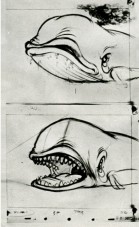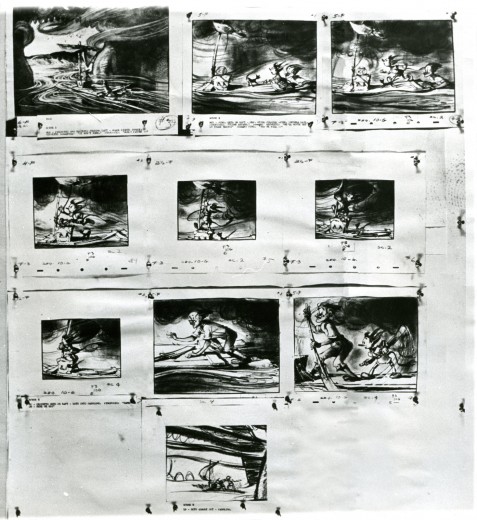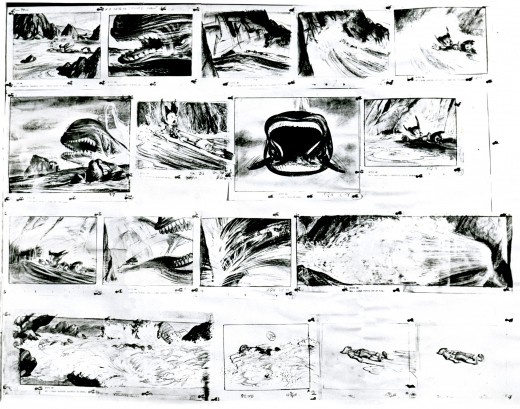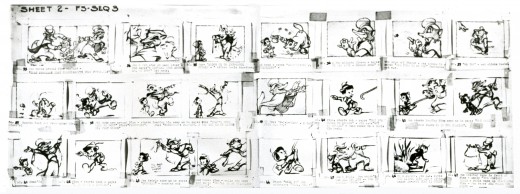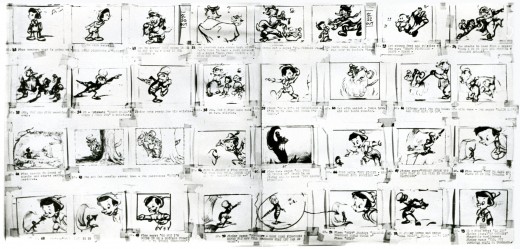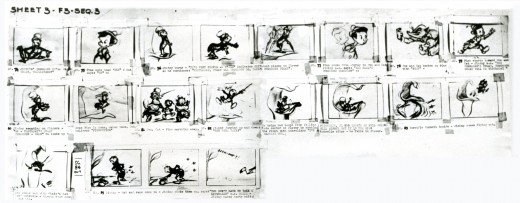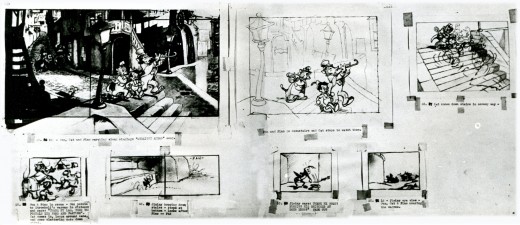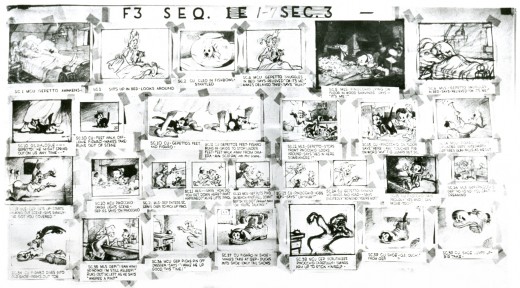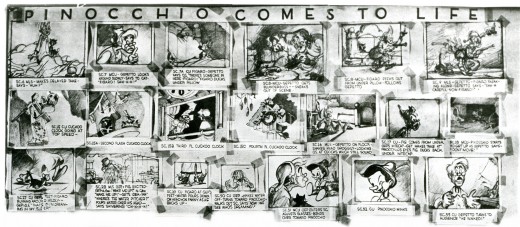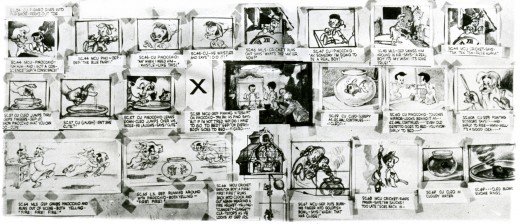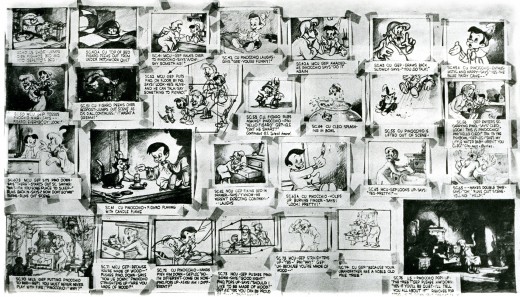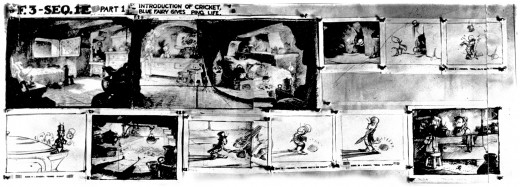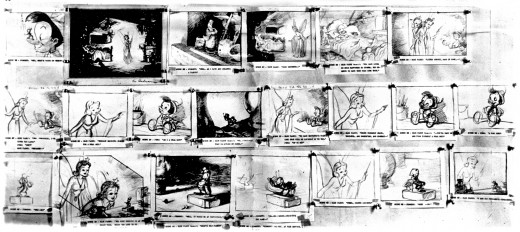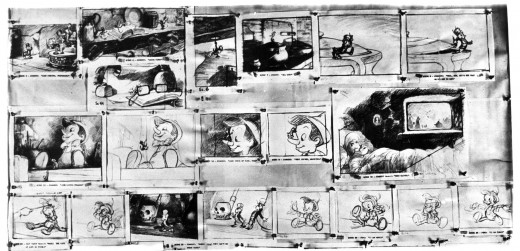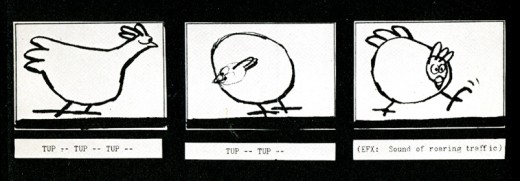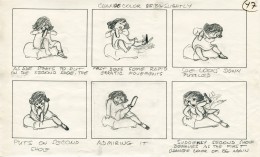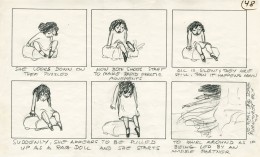Category ArchiveStory & Storyboards
Animation Artifacts &Story & Storyboards 02 Apr 2007 07:41 am
Monstro Sneezes
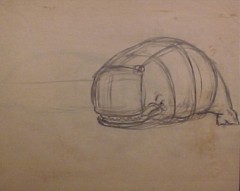 – These are the last of the pages of storyboard I have from Pinocchio. It’s the big climax: Pinocchio and Gepetto, on the raft within the belly of the beast, escape and make it to shore.
– These are the last of the pages of storyboard I have from Pinocchio. It’s the big climax: Pinocchio and Gepetto, on the raft within the belly of the beast, escape and make it to shore.
They’ve started a fire of their only safety within and are hoping it’s going to make Monstro open his mouth so that they can escape.
The drawings are all large scale images on five hole animation paper. They’re pinned to the board as opposed to the tape used in some of the earlier pages, and it feels a bit more of a working board than others of this series. However, I assume this is still for some kind of publication.
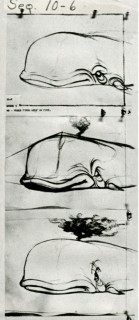 Of note is this first page of Monstro poses. It really details the action as Monstro works up a sneeze. These certainly look like animation drawings rather than storyboard. Note the perspective ruling for the front of the whale on the second and last image.
Of note is this first page of Monstro poses. It really details the action as Monstro works up a sneeze. These certainly look like animation drawings rather than storyboard. Note the perspective ruling for the front of the whale on the second and last image.
.
(Click any image to enlarge.)
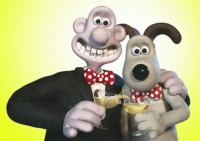 The Animation Guild Blog directs us to this article in The London Times which tells us the Aardman and Sony will soon be in business together. After the Dreamworks breakup, it was expected that Aardman would eventually find a new home, and it looks as though they’ve found one. The announcement is expected to be made official today, Monday, by Sony.
The Animation Guild Blog directs us to this article in The London Times which tells us the Aardman and Sony will soon be in business together. After the Dreamworks breakup, it was expected that Aardman would eventually find a new home, and it looks as though they’ve found one. The announcement is expected to be made official today, Monday, by Sony.
Extra note: SONY made it official. There was a formal announcement via Variety that said Aardman and Sony will work together, but they haven’t decided on the first film.
Jaime Weinman has directed us to the closing sequence to Variety Girl which features great caricatures of celebrities by T. Hee. This film also includes a wonderful puppetoon sequence by George Pal (not shown on YouTube.) A take off on Cinderella, it pretends to be a backstage view; it’s charming. I believe T. Hee had a hand in writing it.
Animation Artifacts &Story & Storyboards 29 Mar 2007 08:00 am
More Monstro
- The next section of the storyboard I have available to post, shows Gepetto in the belly of the whale and his reunion with Pinocchio.
Unfortunately, here, the type is almost illegible on the originals. I’ve tried to goose it a bit in Photoshop, but I don’t think I had much success, unless I want to destroy the images.
There are actually three pages here. Two worked lateral to each other, so I’ve attached them so that you can view it more easily. Boards I’ve marked 5b and 5c are longer than the past boards (and look smaller as thumbnails.) I hope they don’t take too long for you to enlarge and download.
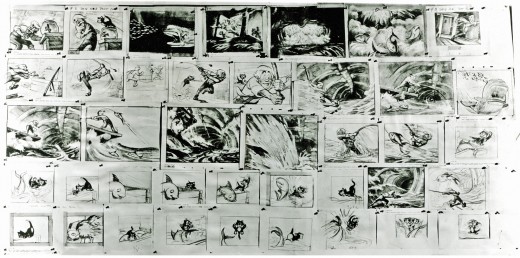 5a
5a
(Click on any image to enlarge.)
Thanks, again, to John Canemaker for lending the boards to me for posting; thanks to Borge Ring for giving them to John, and Dave Hand for giving them to Borge.
Animation Artifacts &Story & Storyboards 26 Mar 2007 08:46 am
MONSTRO
- The pieces of the Pinocchio storyboard I’ve been presenting are missing whole chunks of the film. We jump to the underwater scene where Monstro wakes up.
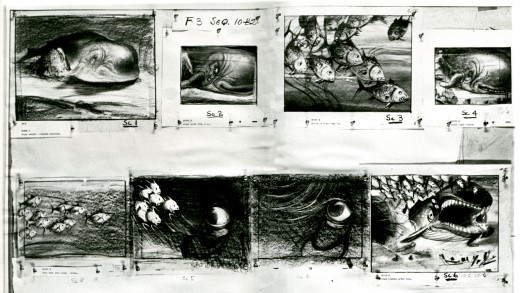 4a
4a
 4b
4b
(Click any image to enlarge.)
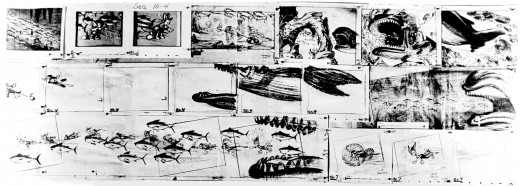 5a
5a
 5b
5b
Unlike the earlier posted segments, these are pinned to the board, and the drawings are done on the large animation paper used at Disney in the late 30′s. Each image would be about 12½ x 15½ on five hole paper. That’s a big board.
Just a reminder. Mark Mayerson continues to do a bangup job of posting his “Mosaic” of the entire film of Pinocchio, based on Hans Perk‘s posted Drafts. Mark’s comments are at least as valuable as the “Mosaics”. Visit his site if you haven’t yet and love Pinocchio.
Animation Artifacts &Story & Storyboards 23 Mar 2007 08:11 am
Pinocchio Rides
- Well, we’re going to skip a couple of sequences for the next storyboard segment I have available from Pinocchio. The first is the Lobster Inn where we meet the coachman as he conspires with Foulfellow the Fox and Gideon the cat. They plot on kidnapping little children for a coach ride to Pleasure Island.
The boards seem to be missing all of Stromboli and Pleasure Island. I’ll post what I have.
Again, I’m splitting these boards in two laterally for the largest size resolution.
Thanks, once more, to John Canemaker; Borge Ring for giving them to John, and Dave Hand for giving them to Borge.
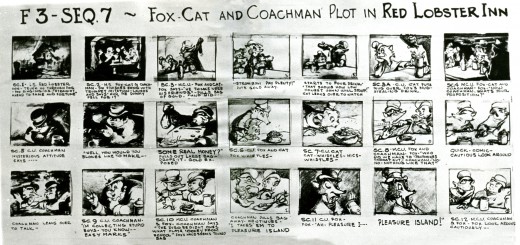 1a
1a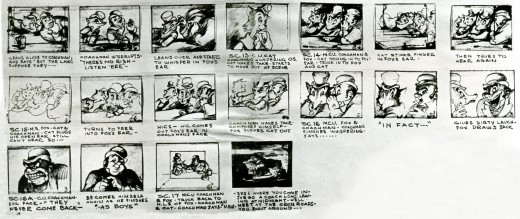 1b There’s a nice flow to some of this page and some decent reaction shots which we hadn’t seen in any other of this board.
1b There’s a nice flow to some of this page and some decent reaction shots which we hadn’t seen in any other of this board.
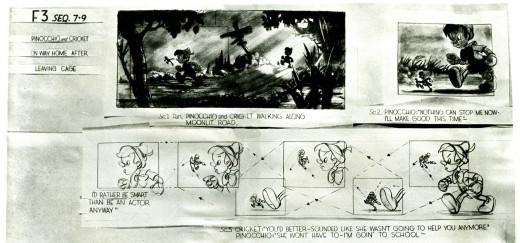 2a
2a 2b
2b
This page seems a bit different than others. The images are a bit more detailed and are spread out. I’m still not sure what purpose these boards served. Interesting that the images are taped and not pinned up. They’re obviously storyboard images regathered for some purpose, possibly a publication.
MONSTRO on Monday.
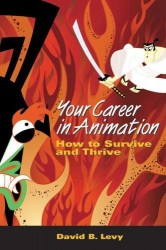
ASIFA-East President, David Levy, will be on radio today. The show NON FICTION is hosted by Harry Allen. Tune into WBAI-NY / 99.5 FM at 2:05 PM. The segment is scheduled to last 20 minutes.
Listen on line here.
SpornFilms &Story & Storyboards 21 Mar 2007 08:00 am
Story (board)
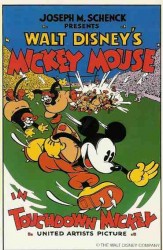 – With all this presentation of storyboards and storyboard documents, it was a real find to come upon the document Didier Ghez posted on his site, Disney History. It’s a story outline from Walt, himself, for the 1932 short Touchdown Mickey. The telling piece comes from the collection of Mark Sonntag.
– With all this presentation of storyboards and storyboard documents, it was a real find to come upon the document Didier Ghez posted on his site, Disney History. It’s a story outline from Walt, himself, for the 1932 short Touchdown Mickey. The telling piece comes from the collection of Mark Sonntag.
Obviously, there was something of a real give-and-take in the Disney films re script vs storyboard creation. Thanks to Merritt & Kaufman’s Walt In Wonderland, we saw documents like this for the silent shorts. However, I don’t remember too many treatments published for the sound shorts.
Of course, if this is the case for the short films, it’s obvious that more elaborate treatments were done for the features.
Oddly, this resembles the “scripts” written for the Larry David Show. On the set of that show the actors improvise dialogue around the breakdowns Larry David writes. The improvisation develops on its own and is pared down or built up in the editing of the final films.
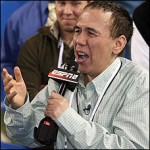 We did something like this in the making of The Little Match Girl. We’d hired Gilbert Gottfried in 1989 – long before Aladdin – to improvise the narration track in the recording studio. My writer, Maxine Fisher, had to write a one-page treatment of the Anderson tale for Gilbert to take into the recording booth. He read the treatment and kept elaborating on it making a lot of jokes as he read.
We did something like this in the making of The Little Match Girl. We’d hired Gilbert Gottfried in 1989 – long before Aladdin – to improvise the narration track in the recording studio. My writer, Maxine Fisher, had to write a one-page treatment of the Anderson tale for Gilbert to take into the recording booth. He read the treatment and kept elaborating on it making a lot of jokes as he read.
The full track was cut down to the half-hour format, and we storyboarded that. Adjusting. Adjusting Adjusting. (Gilbert Gottfried)
.
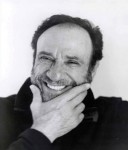 Eventually, the overseas distributor, the video client, and HBO all asked us to get rid of the angry, yelling voice. They were financing it, so I had to, sadly, alter the track. It became a massive job since the cadences of Gottfried were so different from anyone else. 1/3 of the animation had been completed, and a lot of changes had to happen.
Eventually, the overseas distributor, the video client, and HBO all asked us to get rid of the angry, yelling voice. They were financing it, so I had to, sadly, alter the track. It became a massive job since the cadences of Gottfried were so different from anyone else. 1/3 of the animation had been completed, and a lot of changes had to happen.
We wrote a script from the old storyboard, including some of Gilbert’s jokes, and F. Murray Abraham did a great job of acting out the new narration.
(F. Murray Abraham)
In the end, I had a bit of difficulty watching the film again. It had taken so many turns. Sheila Nevins, the chief at HBO, asked me six months later if I thought this my best film. She loved it so much. I had to watch the movie again to think about it.
Stuff happens.
Sorry for that riff, but I guess this story is on my mind since we’re releasing the dvd of The Little Match Girl in companionship with The Red Shoes this coming June. We’ve been making “The Making ofs … ” for the past couple of months, and I’ve been thinking about it.
I still do think a lot about the script/storyboard/script methodology and have seen a lot of variations. I couldn’t help but point one out. I also have a lot more to say on the subject, but I’ll hold off for another time. I have a UPA storyboard by T.Hee I want to show you.
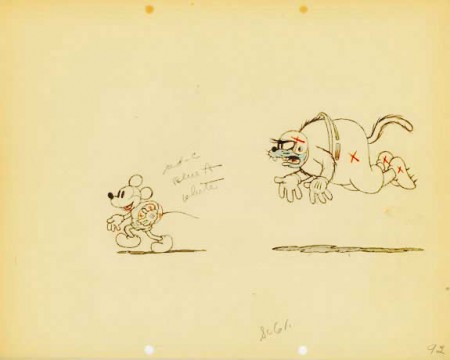
It’s interesting that I own a 16mm copy of Touchdown Mickey as well as the dvd, of course. I’ve seen the short many times and like it, but I have a lot of other B&W ones I like more. Now if it were Baseball Mickey I might feel differently.
Animation Artifacts &Story & Storyboards 19 Mar 2007 08:07 am
Pinocchio Board #3
- Here’s the third installment of the Pinocchio storyboards loaned to me by John Canemaker.
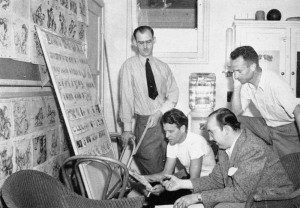 A bit of history about these boards seems appropriate. In the early 1950s, Dave Hand (the director of Snow White and Bambi, among others) gave the photos of these pages to Borge Ring (brilliant Oscar-winning Dutch animator). This information came from Hans Perk on his excellent blog A Film LA as he completed posting all the Drafts to Pinocchio.
A bit of history about these boards seems appropriate. In the early 1950s, Dave Hand (the director of Snow White and Bambi, among others) gave the photos of these pages to Borge Ring (brilliant Oscar-winning Dutch animator). This information came from Hans Perk on his excellent blog A Film LA as he completed posting all the Drafts to Pinocchio.
Borge brought in a photographer to rephotograph these boards which he gave to John. Years later they were loaned to me, and I’m posting them.
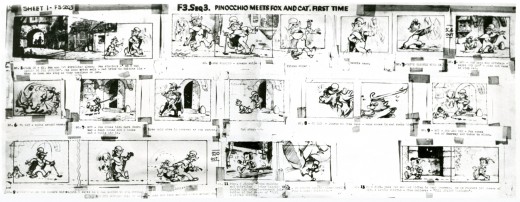 1a
1a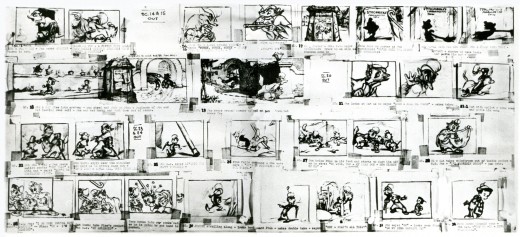 1b
1b
(Click any image to enlarge.)
Animation Artifacts &Story & Storyboards 16 Mar 2007 08:09 am
Pinocchio Board #2
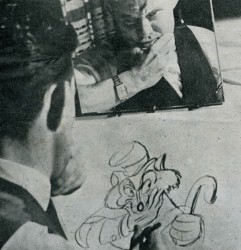 - Here’s the continuation of some of the Pinocchio storyboards which were loaned to me by John Canemaker. As Eddie Fitgerald and Floyd Norman pointed out in comments, these probably aren’t continuation boards; certainly they wouldn’t title one “Pinocchio Comes To Life.” My guess is that these were photographed for publicity, or else perhaps they’re early versions (except that the characters are obviously on model.)
- Here’s the continuation of some of the Pinocchio storyboards which were loaned to me by John Canemaker. As Eddie Fitgerald and Floyd Norman pointed out in comments, these probably aren’t continuation boards; certainly they wouldn’t title one “Pinocchio Comes To Life.” My guess is that these were photographed for publicity, or else perhaps they’re early versions (except that the characters are obviously on model.)
The two boards here seem to be two versions of the same sequence but different. The first one is compressed with lots of captions underneath the images; the second board is more spread out, more in the flow of the other boards.
(Click any image to enlarge.)
Regardless of why these boards were constructed, they contain images and thoughts that are good to see. Here they are; Gepetto discovers a real boy that was once a puppet:
Addendum: the images have been rearranged per comments of “the spectre” below. Now 1a goes to the left of 1b. 2a goes to the left of 2b.
Animation Artifacts &Story & Storyboards 14 Mar 2007 08:16 am
Pinocchio Board #1
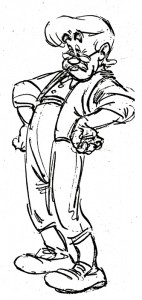 – John Canemaker came for a short visit and brought the real gold with him. He’s loaned me the photographic stats of the Pinocchio storyboard. The entire board isn’t there, but there’s sure a lot of it. We start with the Blue Fairy sequence. F3-1.3.
– John Canemaker came for a short visit and brought the real gold with him. He’s loaned me the photographic stats of the Pinocchio storyboard. The entire board isn’t there, but there’s sure a lot of it. We start with the Blue Fairy sequence. F3-1.3.
So I’ll post it a bit at a time. They’re large scans that have to be reconstructed in photoshop, and I’m doing that as time permits. I’m also trying to clean it up a bit since it’s a rather dark image. I’m trying to post it at the highest possible resolution so that it can be read, but that means I have to cut it in half again or it otherwise won’t load. (Since the board reads across row by row, I’m splitting it lengthwise to make reading easier.)
The type is still a bit small, but it’s the best I can do.
It’s a gem and something that should be out there now while Hans Perk posts the Drafts to the film and Mark Mayerson continues his Mosaic of the entire film. Hopefully, I’ll be able to catch up and keep up with him – a couple of posts a week.
Happy reading:
Animation Artifacts &Hubley &Story & Storyboards 28 Feb 2007 08:04 am
Hub Boards
- The conversation on storyboard use goes way back – before the internet. If you check out the 1969 book by John Halas, Techniques of Film Animation, there’s a Q&A session wherein a number of animation greats were asked several questions, and the answers are given by question.
Here’s one question about storyboards and the answers given:
To what extent to you think a storyboard should be developed prior to production?
- GENE DEITCH: I believe in complete scene and shot breakdown in story-board or a thumbnail board form before production begins. I use a thumbnail storyboard as a sort of bar-sheet, indicating all effects, dialogue and music cues, scene transitions, etc. Great savings in cost, and an overall perspective of the film in advance are to be gained.
JOY BATCHELOR : As fully as possible without detriment to the following phases of production.
STEHPEN BOSUSTOW: If time and money allow, the storyboard should include as many details as possible, particularly if it is to be assigned to a large production unit. However, if only a few people are to be working on the picture, the storyboard can be quite sketchy, with the details being developed during production by the key people who have an overall feeling for and knowledge of the story.
ADRIAN WOOLERY: The storyboard is the first step, after the idea. Every problem must be solved and the story completely resolved on the board prior to consideration of any production.
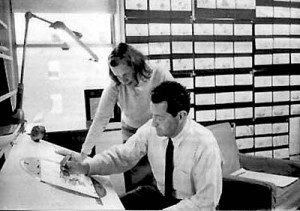 JOHN HUBLEY: It has been my experience that the more detailed a story-board and the more carefully it is designed to reflect the appearance of the finished production, the more successful the film.
JOHN HUBLEY: It has been my experience that the more detailed a story-board and the more carefully it is designed to reflect the appearance of the finished production, the more successful the film.GEOFFREY SUMNER: The storyboard, or breakdown of the film, has as many different forms as there are ways of putting actions in relation to one another.
The classic storyboard is the set of working drawings of the sequence of a film used in large studios on the Disney model where numbers of subsidiary workers must conform to a total pattern they can almost never see.
It is used in conjunction with model sheets. It could be called the “model sheet” of the sequence of the film.
It is strictly for use within a studio and should not be shown to dangerous people like sponsors.
An earlier stage is the treatment, which can be specifically directed at sponsors. If the basic idea of the film is simple, the treatment need be no more than half a dozen drawings and a brief synopsis to convey a ten minute film.
A storyboard must necessarily be constructed after the music has been done. The musician and the director can work together from a stage following the treatment. From the finished recorded track the storyboard is made.
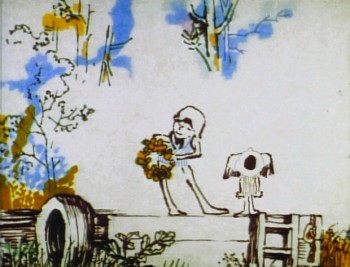 For years prior to even meeting Hubley, I had remembered his response to this question. It impressed me. His storyboard development was pretty intense. The scripts generally were done visually and tacked to the wall.
For years prior to even meeting Hubley, I had remembered his response to this question. It impressed me. His storyboard development was pretty intense. The scripts generally were done visually and tacked to the wall.
I don’t remember ever seeing text up there. John would present the board to key people, and he would give an indication of dialogue verbally. We all knew this would ultimately be ad-libbed by actors.
With the Carousel feature, sections were boarded but then developed in greater  length through improvised sessions. The boards then grew out of the edited tracks. The voices often came first, here.
length through improvised sessions. The boards then grew out of the edited tracks. The voices often came first, here.
I suspect this is probably also true of the films like Cockaboody, Windy Day and Moonbird which were dependent on the children’s verbal play at the microphone. Something like The Hole or Voyage To Next were boarded visually, then recorded improv sessions which were adapted in newer boards.
Of course it has to be remembered that the two features done within this studio, Everybody Rides The Carousel and Of Stars and Men, both started out as text. Both were heavy-duty books that were adapted for film. In the case of Of Stars and Men, the author, mathematician Harlow Shapely had major involvement in the film’s script and narrated it as well. The concepts for both films were fully worked out before anyone started boarding. So essentially a script – of sorts – existed. Since CBS financed Everybody Rides The Carousel, you know they had to approve a script.
I, of course, only remember the board.
Story & Storyboards 27 Feb 2007 08:05 am
Boards
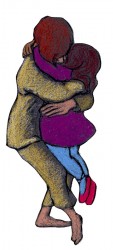 Mike Barrier continues the script vs. storyboard dialogue in some recent posts. I think this was recently prompted by some comments on Eddie Fitzegerald‘s site. Eddie sides with the storyboard lead, and all the comments on his blog, naturally, back him up. It’s John Krisfalusi‘s viewpoint, and it works for them in a somewhat hardened way.
Mike Barrier continues the script vs. storyboard dialogue in some recent posts. I think this was recently prompted by some comments on Eddie Fitzegerald‘s site. Eddie sides with the storyboard lead, and all the comments on his blog, naturally, back him up. It’s John Krisfalusi‘s viewpoint, and it works for them in a somewhat hardened way.
Mike Barrier is less dogmatic. His is the historian’s approach, and he talks primarily about ways others have worked. This approach to the argument appeals to me since I’m curious about what others have done in the past to make some of their great films.
However, in all honesty, I have to say that I’ve enjoyed reading both sides of the argument without any emotional involvment. None of it seems to match the way we’ve done films in my studio. I suspect this is true of all individual studios; methods are developed which work, and that’s the route followed. It also seems to vary with each and every film.
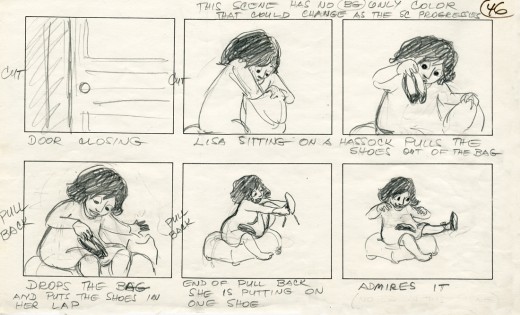 These are a few pages from my film The Red Shoes. This storyboard for a non-verbal section was done by Tissa David from a script by Maxine Fisher. The board changed the script. The LO’s changed the board, and Tissa’s animation of her own board & LO’s changed that.
These are a few pages from my film The Red Shoes. This storyboard for a non-verbal section was done by Tissa David from a script by Maxine Fisher. The board changed the script. The LO’s changed the board, and Tissa’s animation of her own board & LO’s changed that.
I love construction so feel that you have to work with a script. I’m not sure you can see a larger picture (for anything other than short films) with a storyboard only approach. However, after scripts are written, I generally ignore all descriptions of specific action after my initial reading. In doing the storyboard, I prefer to come up with my own movement to build around the dialogue. This is also a stage where I’ll eliminate a lot of dialogue (if I can).
Once the board is done, I go back to reread the script to see if the writer had anything more interesting than what I’ve come up with. Usually there is, and I’ll then plug this action into the board. We then do a rough animatic to see how it works and fix rough spots. Then it’s back to rewrite the script.
The film is always alive for me. If the actor improvises a better line, that’s the one. If we can make it better in Layout, we will. If we can change it to make the animation better, we will. If Coloring the piece offers a better idea, we’ll take it. Flexibility is the key. I make decisions and changes on the spot and live with them. Directing is dangerous.
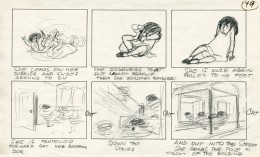
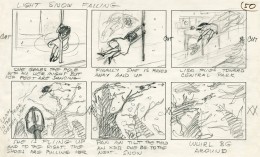 Tissa viewed an animatic we constructed to a tempo. She animated to the overall timing we gave her, but she changed the tempo and animated the four minute dance to a beat. Caleb Sampson had very little time, so he composed the music to the beat, and we made it work to Tissa’s final scene.
Tissa viewed an animatic we constructed to a tempo. She animated to the overall timing we gave her, but she changed the tempo and animated the four minute dance to a beat. Caleb Sampson had very little time, so he composed the music to the beat, and we made it work to Tissa’s final scene.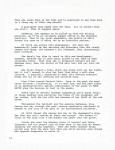
I like surprises. When an actor reads the line the way I’ve heard it in my head, it’s usually not the best reading. I want more personality. I tend to laugh at these surprises, and the actors become confused by my laughing during their dramatic readings.
This is true of every stage of production. I also love seeing unexpected happy bits in the animation. It’s all about the acting, the performance of the characters as channeled by the actors and animators.
(Script page – click to enlarge.)
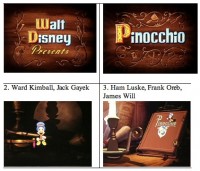 Mark Mayerson has begun a Mosaic culled from the information taken from the Drafts Hans Perk is posting on his site.
Mark Mayerson has begun a Mosaic culled from the information taken from the Drafts Hans Perk is posting on his site.
These Mosaics are a treasure from Mark; a quick visual reference to the film and the animators involved in the particular scenes. The amount of work he puts into them is enormous, and I couldn’t be more thankful. The same goes out to Hans for posting the Drafts.
With a work as monumental as Pinocchio, one can’t study it enough, and Mark’s Mosaics make it a little too easy for all of us.
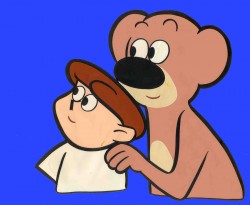 - Last year I wrote about Spunky & Tadpole. The post elicited some response. Most recently, Charles Brubaker wrote to tell me that an episode of the series has popped up on YouTube and can be reached here.
- Last year I wrote about Spunky & Tadpole. The post elicited some response. Most recently, Charles Brubaker wrote to tell me that an episode of the series has popped up on YouTube and can be reached here.
The episode almost looks as though it were shot off a tv screen, and that video was transferred to YouTube. Lots of color deterioration. However, it doesn’t look as bad as one might expect. Spunky and Tadpole wasn’t animated in Flash and looks better for it, despite the low quality transfer. (Click images to enlarge.)
